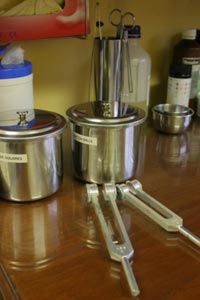Non-musical Uses for Tuning Forks
While keeping orchestras and concert bands in check, tuning forks have also found plenty of work in hospitals, research labs and police stations around the world.
Among some audiologists, tuning forks remain a preferred method of testing for certain types of hearing loss. In a method known as a Rinne test, a doctor first holds a humming tuning fork to your skull and, using a stopwatch, times how long you can hear it. The doctor then strikes the tuning fork again and times how long you can hear it when it's held next to your ear. If you can hear the tuning fork through your jaw longer than you can hear it against your ear, you have a problem conducting sound waves through your ear canal. In a similar test (known as the Weber test), a vibrating tuning fork is held in the middle of a patient's forehead. By figuring out which ear hears the tuning fork the loudest, the doctor can zero in on which ear is damaged.
Advertisement
When X-rays are in short supply, tuning forks can also be a makeshift way to identify whether a bone is fractured. Simply hold a ringing tuning fork close to the site of a suspected fracture. If you feel a sudden surge of pain, it's time to go to the hospital.
Over the last 15 years, tuning forks have also been getting a fair bit of attention in the world of alternative medicine. In a practice known as tuning fork therapy, a patient lies motionless on a table while a healer passes vibrating tuning forks over their body -- the idea being that the vibrations improve mental clarity and physical energy. There's no scientific evidence for this, but hanging out in a room filled with gently-humming tuning forks could put anyone in a good mood.
Ever gotten a speeding ticket? A tuning fork is partly responsible. Police radar guns measure speed by bounding a radar signal off an approaching car. Depending on how quickly the radar signal bounces back determines how fast the car is going. To calibrate a radar gun, police will aim it at a tuning fork specially designed to vibrate at 50 miles per hour (80.5 kilometers per hour). If their radar gun doesn't register 50 miles an hour, they know it's time to take it in for adjustment.
For lots more information on music and technology, give your brain a tune-up with the links below.
Related Articles
- How Hearing Works
- Why do loud noises cause your ears to ring?
- What is a decibel and what is the loudest sound I can listen to before it hurts my ears?
- What causes the sound of a heartbeat?
- What causes tone deafness?
- How Speakers Work
- Why can you hear the ocean when you hold a seashell to your ear?
- What is white noise?
Sources
- Allan, David. W. Brzoticky, Frank H. "Calibration of police radar instruments." Report of the 60th National Conference On Weights and Measures. May, 1976.
- Arno Barthelmes & Co. "Production." (Feb. 11, 2011) http://www.barthelmes.info/englisch/produktion.html
- Burleigh, David T. Fuierer, Paul A. "Tuning forks for vibrant teaching." JOM. November 2005. (Feb. 11, 2011) http://www.tms.org/pubs/journals/jom/0511/burleigh-0511.html
- Case Western Reserve University. "Tuning fork." (Feb. 20, 2011) http://www.phys.cwru.edu/ccpi/Tuning_fork.html
- Kaplan, Matt. "Prions picked up by tuning fork detector." Nature.com. March 27, 2008. (Feb. 11, 2011)http://www.nature.com/news/2008/080327/full/news.2008.696.html
- Kenyon College. "Tuning Forks." (Feb. 11, 2011) http://physics.kenyon.edu/EarlyApparatus/Acoustics/Tuning_Fork/Tuning_Fork.html
- Lazaruk, Susan. "Did bad vibrations cause cave-in?; Engineers say the bouncing of dancers may have created waves 'like a tuning fork." The Province. May 8, 2010.
- Lewin, Elisabeth. "Need a Virtual Tuning Fork? There's An App For That." June 4, 2009. (Feb. 11, 2011) http://www.podcastingnews.com/content/2009/06/need-a-virtual-tuning-fork-theres-an-app-for-that/
- Musurgia.com. "Daguerrotype of a Choirmaster." (Feb. 11, 2011) http://www.musurgia.com/products.asp?ProductID=1607&CartID=4645361262011
- PhysicsClassroom.com. "Longitudinal Waves and Tuning Forks." (Feb. 11, 2011) http://www.physicsclassroom.com/mmedia/waves/tfl.cfm
- PhysicsClassroom.com. "The Nature of a Sound Wave." (Feb. 11, 2011) http://www.physicsclassroom.com/class/sound/u11l1c.cfm
- Robinson, Allan. "Learning to Use Tuning Forks." Jan. 8, 2010. (Feb. 11, 2011) http://www.livestrong.com/article/71771-learning-use-tuning-forks/
- Sengpiel Audio. "Chord name finder by note entry." (Feb. 20, 2011) http://www.sengpielaudio.com/calculator-notenames.htm
- Serway, Raymond A. Vuille, Chris. Faughn, Jerry S. "Producing a Sound Wave." College Physics, Volume 10. 2008.
- Snopes.com. "Tuning fork shatters teeth/explodes eyeball?" May 22, 2007. (Feb. 20, 2011) http://message.snopes.com/showthread.php?t=9069
- Tools for Wellness. "Tuning forks for sound therapy." (Feb. 20, 2011) http://www.toolsforwellness.com/tuning-forks.html
- TuningForkTherapy.com. "History." (Feb. 20, 2011) http://www.tuningforktherapy.com/about.html
- Wayne State College. "Lecture XII - General Physics (PHYS 2130)." (Feb. 11, 2011) http://www.physics.wayne.edu/~apetrov/PHY2130/Lecture12.pdf
- Webster University. "The Rinne Test." (Feb. 11, 2011) http://www.webster.edu/~davittdc/ear/rinne/rinne.htm
